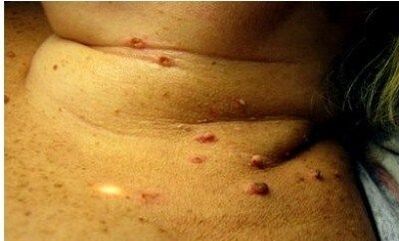
Looking at various photos of papillomas in women, it is unlikely that anyone will want such neoplasms to appear on your body.But growths can form at the most inopportune moment and sometimes in extremely unpleasant places.
The same papillomas on the female genital organs, in the urethra or papillomas of the bladder in women are much more dangerous than simple warts on the body.How to determine what to do with them and to whom to contact?You will find an answer in this material to these and many other questions.
The reasons for the formation of papillomas
The main causes of growths are the penetration of various strains of the human papillomavirus into the body.The type 16 of the type 16 in women, 18 and 31, is considered dangerous. We will talk about them later.
Type 16 viruses in women, 18 or 31 in women are only a small share of those varieties that have been discovered to date.At the same time, scientists are sure that more than one variety will be discovered in the near future.
The course of the disease, the nature of external manifestations and the complexity of the treatment of papillomas largely depends on the type of human papilloma virus in women.
The virus can penetrate in several ways:
- Sexual contact.The most potentially dangerous path, since the type 31 is transmitted through it, as well as viruses of type 16 in women and 18. Many people think that the manifestation of HPV is impossible if condoms are used.In fact, this is a delusion, since the condom is not able to protect the condom fully from the HPV.What can we say about unprotected oral and anal sex, as well as the practice of non -traditional relationships.
- Contact-household.The second most popular path, due to which infection in women can penetrate their body.These are ordinary handshakes, hugs and kisses, as well as the use of common hygiene items, various tools, etc. Such a transmission path is possible if there are some damage, small wounds or scratches on the body.
Papilloma of the 16th type in women, 18 and 31 are dangerous with their oncogenicity.That is, the probability of encountering cancer tumors is much higher if the type 18 of type is found in women, 16 or 31.
The very fact of the presence in the body of the virus, even if it will be 16, 18 or 31, does not guarantee the mandatory manifestation of papillomas and even more so the development of cancer.The development of HPV in the body is affected by the general condition and immune system.
Special groups of risk factors are distinguished, due to which the likelihood of infection increases:
- Too early start of active sexual activity.According to statistics, in most cases, women are infected with HPV under the age of 25.
- Regular shifts of partners.
- Frequent abortions.It is not uncommon that sexual intercourse ends with an undesirable pregnancy.The optimal tool for many is an abortion.But because of them, the internal structure of the genital organs is violated, which greatly simplifies the penetration of the virus.
- The presence of chronic diseases of the gynecological type.
- Venus diseases.
- Long -term use of oral type contraception.

What is papilloma?This is only an external manifestation of the virus that sits in the body of a woman.Some papillomas cause only cosmetic defects.Therefore, their removal is a simple need to get rid of growths that spoil the appearance of a woman.But there are situations when a girl must definitely consult a doctor in order to get a full consultation and reveal all the details of the presence of the virus in the body.
It so happened that papillomas in women are more dangerous than in men.And here, not only viruses of type 31 in women, 18 or 16 play a role.
According to statistics, the likelihood of developing malignant neoplasms among representatives of the weaker sex is higher.Therefore, papillomas must be cured.Papilloma discovered in women is a signal to an early visit to the doctor.
Which doctor treats papillomas?It already depends on exactly where the growths occurred.If these are pointed papillomas affecting the genitals and intimate zones, then you should go to the gynecologist.
It is difficult to independently determine the growths on the internal organs, therefore, a complete diagnosis of the body may be required.When warts arise on the skin, you are first sent to a dermatologist.
Types
For women, several groups of neoplasms are relevant:
- Flat papillomas.Typically, flat papillomas affect the cervix and its epithelium;
- Hijacking warts.They are formed due to the effects of the safest strains of the virus;
- Inverted.In many ways, signs of flat growths are reminiscent.With such neoplasms, the precancerous states of the cervix are not rarely diagnosed;
- Sharp.Usually they find themselves on the external labia and in areas injured as a result of sex.New warts may appear near single growths, after which they merge into a single neoplasm.Outwardly resembles cauliflower.
Micropapillomatosis in women is a little different.In general, such a phenomenon is considered the norm.However, when the signs appear that the photograph demonstrates, papillomatosis for infections should be checked.Micropapillomatosis affects the labia (small) and is multiple growths of small sizes.
Consequences
Only a doctor should prescribe the symptoms and treatment.The specialist is able to determine what the neoplasm appeared from, how to treat and what to use the medicine.
Many women, having seen growths in themselves, panic, because they fear complications in the form of cancer.In fact, the percentage of such cases is small and is caused only with gross disturbances for treatment or care for neoplasms.If you do everything competently, not injure and not tear the growths, the probability of complications will be minimal.
But what are the consequences to provoke human papillomas regarding female representatives?
- In most cases, there are no complications.Moreover, as the immune system is strengthened, sometimes you do not even have to resort to the removal of neoplasms.They are absorbed on their own.
- One of the potential dangers is a violation of reproductive function.
- Another complication that can cause HPV is problems when trying to get pregnant.
- The most important threat is the development of cancer neoplasms.
To avoid unpleasant consequences, if signs of HPV are found, you need to periodically visit a doctor and take appropriate tests.If there are no external signs of the virus, it will still not be superfluous to check the fact of its presence.
Practice shows that many women of HPV are in a hidden state, that is, it does not manifest itself in any way.This period can last from several weeks from the moment of infection to several years.Cases are not rare when the growths were not formed throughout life, despite the presence of a virus in the body.
Treatment
Each papilloma in women needs treatment.Another question is whether women need treatment by removal, or you can do with more gentle methods.
Consider several treatment options:
- Treatment with folk remedies.It is recommended to use treatment with folk remedies only with the elimination of underwear.It is impossible to fight such methods with intimate warts or in places with thin skin without consulting a doctor.
- Removing papillomas.Actual in cases where the growths are multiple, they interfere with normal life or cause physical discomfort.After removing papilloma, burning is a normal reaction, especially when it comes to cryodestruction or electrocoagulation.Laser therapy and radiosurgery are preferable, although more expensive.
- Sparing papillomas with medicines.Aims at increasing immunity and suppressing the virus.It can be tablets, injections or ointments for local application to the destination.
If a woman encounters papillomas, you should definitely visit a doctor.It will give specific recommendations, depending on the current situation and the characteristics of the course of the disease.















